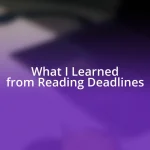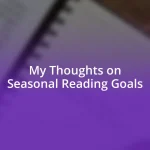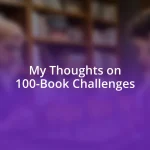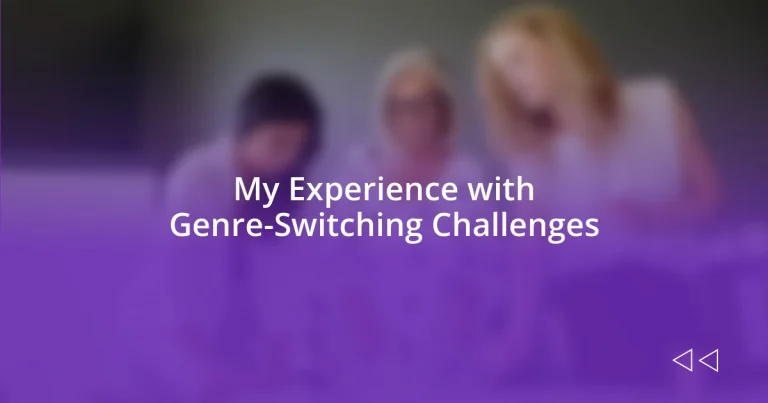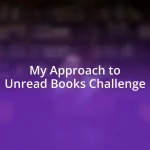Key takeaways:
- Genre-switching can evoke self-doubt but also encourage growth as a writer, revealing personal triggers and emotional responses to inspire creativity.
- Establishing a clear tone, creating voice-driven characters, and revisiting foundational texts are effective strategies for maintaining consistency across genres.
- Successful genre-switchers embrace vulnerability, seek feedback, and engage in continuous learning to enhance their craft and foster deeper connections with readers.
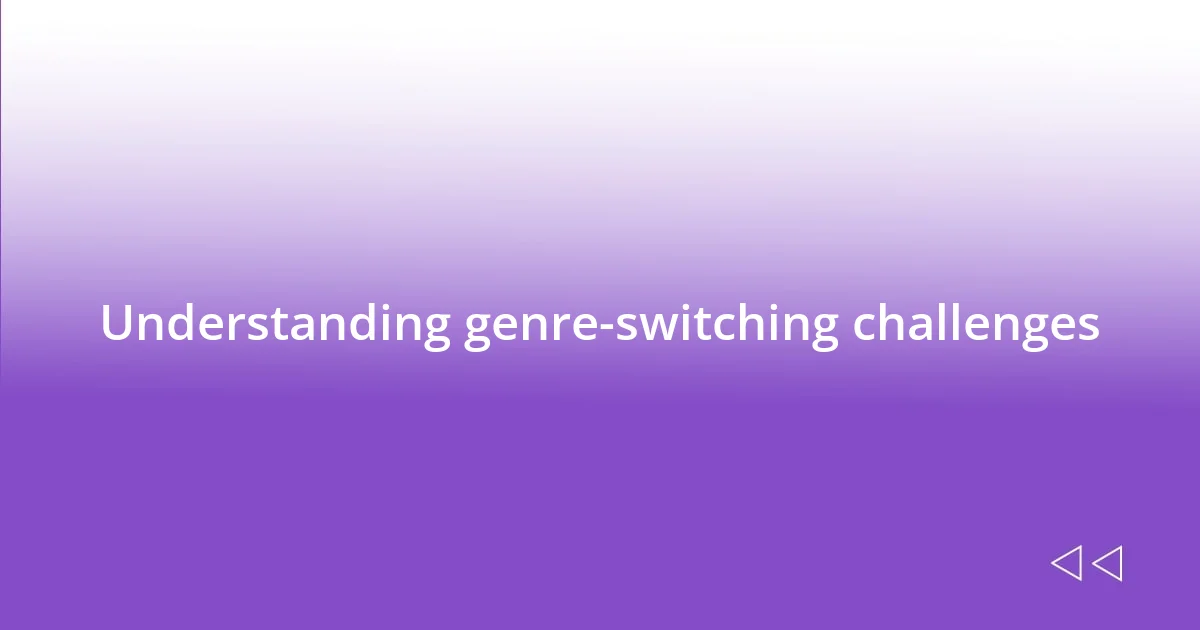
Understanding genre-switching challenges
Switching genres can feel like learning to drive a new type of vehicle. For instance, when I transitioned from writing poetry to crafting short stories, I found myself grappling with the need for a different structure and a more narrative-driven approach. It’s a shift that can be both exhilarating and intimidating, don’t you think?
I remember the moment I first tackled a thriller after years of writing romance; the urgency and pace were like a jolt of caffeine. My hands trembled as I typed faster, desperately trying to match the frenetic energy I’d seen in my favorite novels. This challenge made me question whether I could truly capture that suspense, forcing me to embrace discomfort as part of the learning process.
The emotional rollercoaster of genre-switching often brings up self-doubt. Finding my voice in a new style felt like wandering through a fog without a map. I often asked myself: “Will readers connect with this new direction?” Yet, with each piece I wrote, I discovered not just the thrill of experimenting but also the joy of growth as a writer.
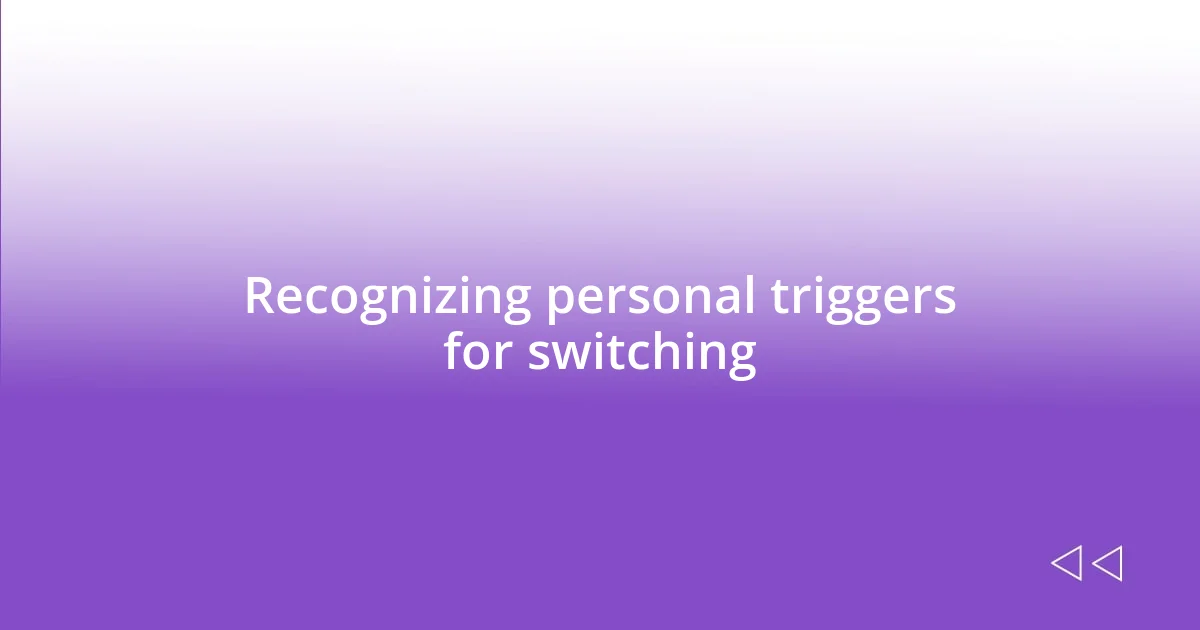
Recognizing personal triggers for switching
Recognizing personal triggers for switching is a crucial step in navigating the challenges of genre transitions. For me, certain emotions act as catalysts—such as nostalgia pulling me back to earlier influences, or frustration sparking a desire to break free from my comfort zone. I’ve found that identifying these triggers can often reveal deeper patterns in my writing journey, helping me understand when and why I want to explore something new.
- Nostalgia for past literary influences
- Frustration with current writing style or genre
- Desire for creative growth and experimentation
- Response to external feedback or trends
- Emotional state influencing creativity (e.g., happiness, sadness)
By keeping an eye on these triggers, I can harness them as tools rather than stumbling blocks. For example, after revisiting some classic fantasy novels, I felt an overwhelming urge to dip my toes back into that genre; it was like reuniting with an old friend. This recognition empowered me to adjust my writing focus, leading to exciting new projects that reignited my passion. Each trigger I acknowledged made the process feel less daunting and more like a journey of discovery.
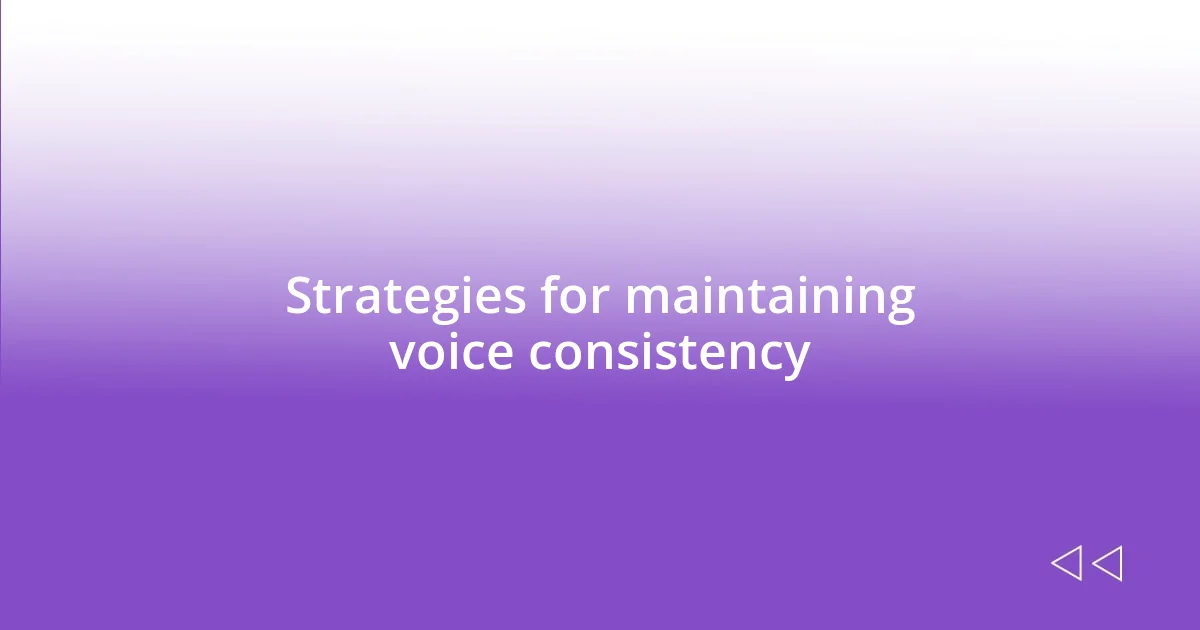
Strategies for maintaining voice consistency
In my experience, one of the most effective strategies for maintaining voice consistency across genres is establishing a clear tone beforehand. Before diving into a new piece, I take time to jot down a few key adjectives that embody the voice I want to convey. For instance, when I shifted from humor to drama, I focused on words like “reflective” and “intense.” This exercise serves as my personal compass, guiding my writing to remain true to the established tone throughout the piece.
Another approach that has truly worked for me is creating a character or narrator that embodies the voice I aim to maintain. In one of my attempts at writing a dystopian novel, I developed a character who balances cynicism with hope. By weaving her perspective into each chapter, I found that my voice naturally aligned with her outlook, keeping the narrative consistent even in high-stakes moments. It’s fascinating how a well-defined character can anchor your writing, don’t you think?
Lastly, revisiting foundational texts that exemplify your desired voice can do wonders. When writing a mystery after years of focusing on travel narratives, I dove back into Agatha Christie’s works. Reading her dialogue allowed me to absorb the rhythm and subtleties of her style. This practice not only refreshed my memory but also inspired me to adopt certain elements, keeping my writing cohesive.
| Strategy | Description |
|---|---|
| Establishing Key Adjectives | Select a few words that define the desired tone before starting a new piece. |
| Creating a Voice Character | Develop a character whose perspective helps maintain a consistent narrative voice. |
| Revisiting Foundational Texts | Read works from authors known for their voice to inspire and inform your own writing style. |
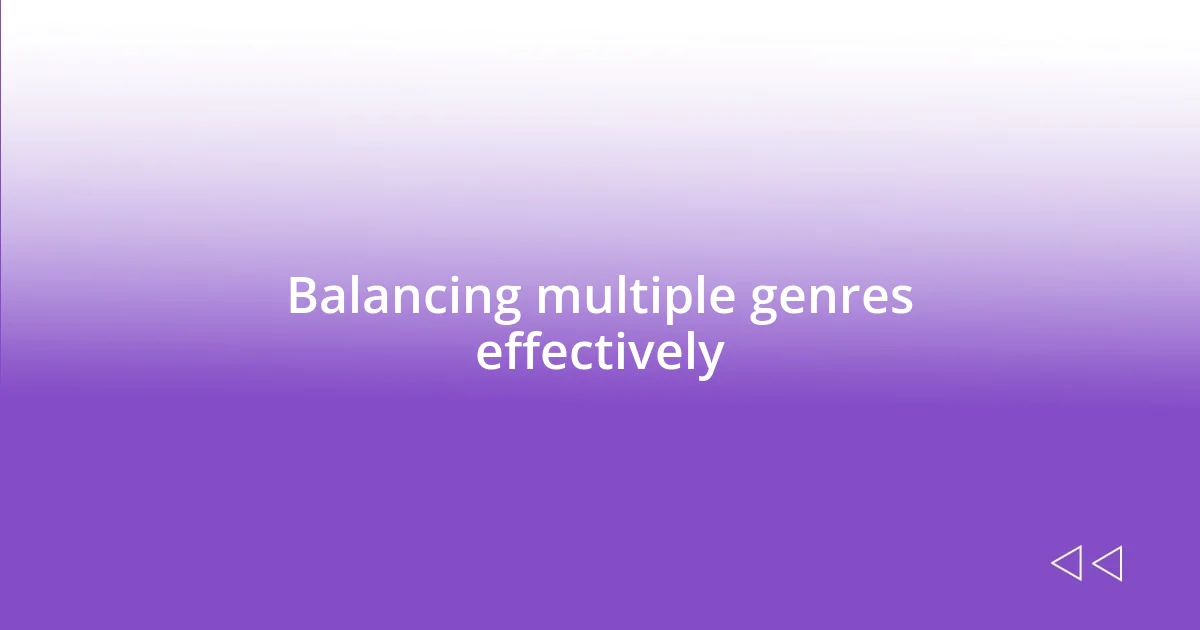
Balancing multiple genres effectively
Finding balance while switching between multiple genres can feel like walking a tightrope. I remember the early days of experimenting with historical fiction after years of writing fantasy. I was excited, yet overwhelmed by the need to merge the sweeping narratives of fantasy with the meticulous detail of historical accuracy. This experience taught me that blending genres isn’t just about throwing elements together; it’s about creating a harmonious rhythm that feels cohesive. Have you ever felt the thrill of combining disparate genres and discovered a new groove? It’s surprisingly rewarding.
One effective approach I’ve adopted is to draw parallels between the emotions present in different genres. For example, while crafting a romance novel, I found that the themes of love and loss from my mystery stories could enhance the emotional depth of my writing. By weaving together emotionally resonant threads from various genres, I was able to create a richer tapestry that resonated with readers on multiple levels. I found joy in realizing that, although the genres differed, the core emotions could unite them.
Moreover, I often create a genre map to visualize how different genres intersect. When tackling a science fiction project combining elements of horror, I sketched out key elements like setting, character arcs, and themes. This helped me foresee potential clashes and celebrate synergies. As a writer, I believe that exploring these intersections can lead to fresh ideas, don’t you? Embracing the challenge of balancing genres opens doors to creative possibilities that I had never considered before.
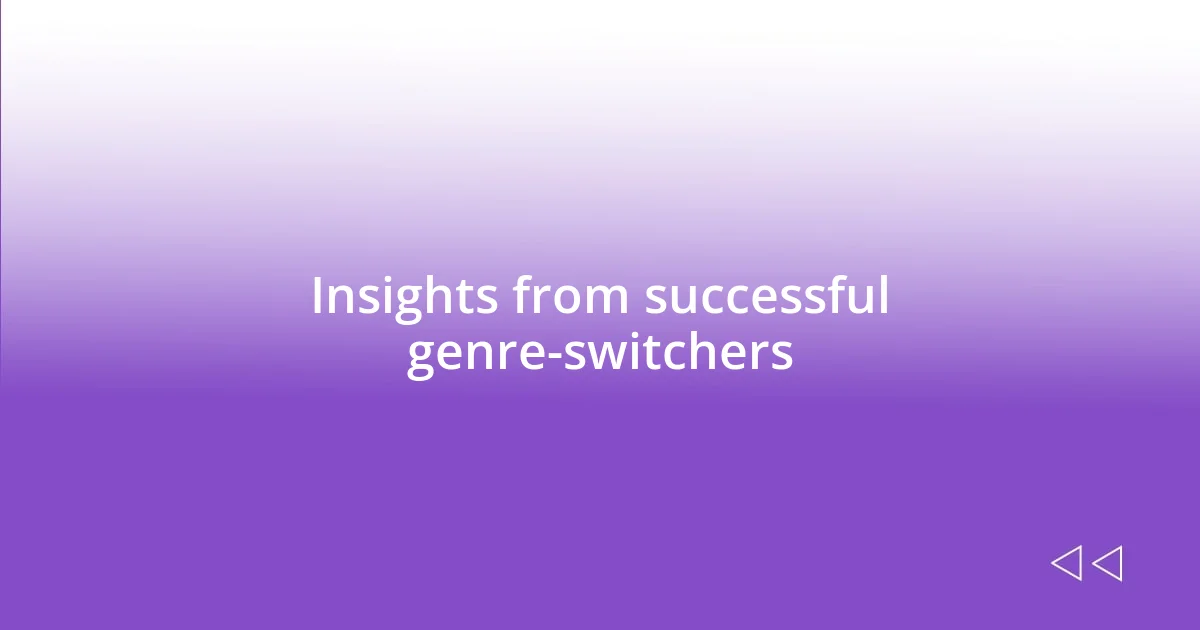
Insights from successful genre-switchers
One striking insight I’ve gained from successful genre-switchers is their ability to embrace vulnerability in their work. I recall chatting with a fellow author who transitioned from light-hearted romance to gritty noir. She shared how she felt exposed writing such raw emotions, yet that vulnerability became the heart of her new stories. Isn’t it fascinating how allowing ourselves to be vulnerable can lead to deeper connections with readers?
Additionally, many writers emphasize the significance of feedback when switching genres. In my own experience, I once shared my first attempt at a psychological thriller with a trusted writing group. Their perspectives highlighted elements I hadn’t considered, such as pacing and tension. The collaborative dialogue not only refined my story but also reassured me that genre-switching is a journey best undertaken with support. Have you ever noticed how fresh eyes can give clarity to our creative vision?
Lastly, I’ve found that successful genre-switchers often advocate for continuous learning. For me, enrolling in workshops focused on different genres has been invaluable. I remember attending a seminar on poetry, which surprisingly unlocked a new ways of thinking about language in my prose. Each genre offers unique tools, and being open to learning from them can enhance our overall writing craft. Isn’t it amazing how one genre can inspire breakthroughs in another?
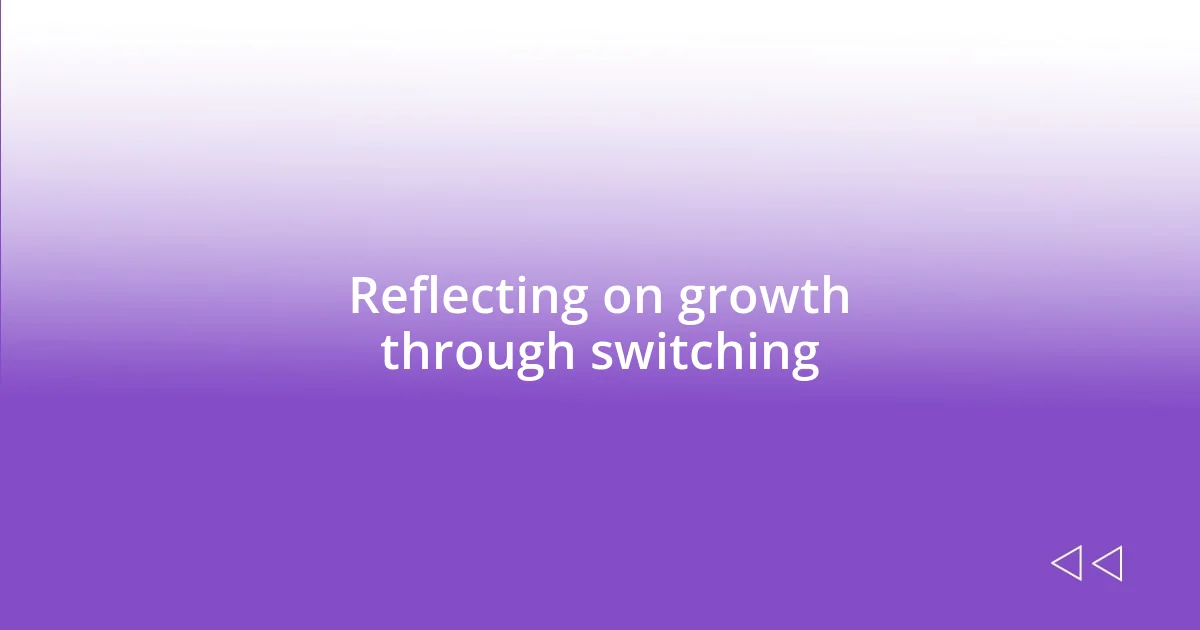
Reflecting on growth through switching
Reflecting on growth through switching provides a valuable lens through which I’ve come to understand my development as a writer. I remember a pivotal moment when I began blending memoir with speculative fiction. The experience was initially daunting, as I grappled with the authenticity of personal narrative against the backdrop of fantastical elements. However, this challenge pushed me to articulate my truths more vividly, ultimately enhancing my storytelling skill. Have you ever felt that moment when a creative leap transforms your perspective?
In my journey, I’ve realized that each genre I explore acts as a mirror, reflecting different facets of my creativity. For instance, drafting a horror story forced me to confront my anxieties in new ways. I found that weaving my own fears into the narrative not only deepened the tension but also made the writing process cathartic. How empowering is it to channel our emotional struggles into a creative outlet?
Moreover, I’ve discovered that growth often stems from the discomfort of stepping outside my comfort zone. Recently, I tried my hand at writing a historical romance. Initially, the meticulous research felt burdensome. However, as I delved deeper, I found joy in the intricate details, transforming what felt like a chore into an avenue for rich storytelling. The result was a piece that resonated with authenticity and passion. Isn’t it fascinating how embracing the unfamiliar can lead to unexpected revelations in our craft?




